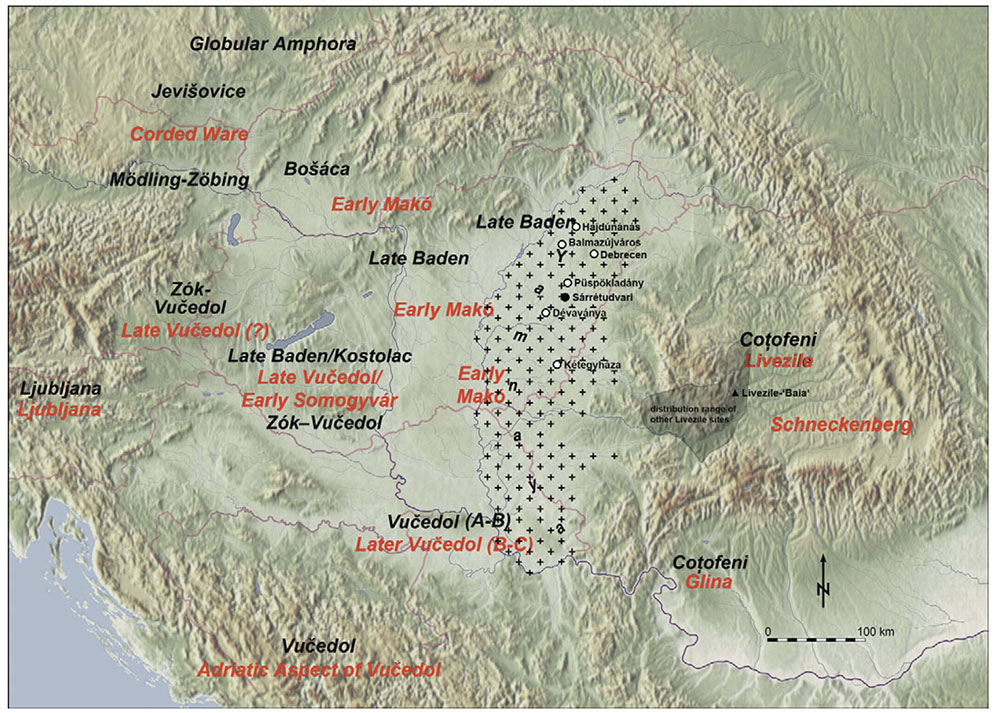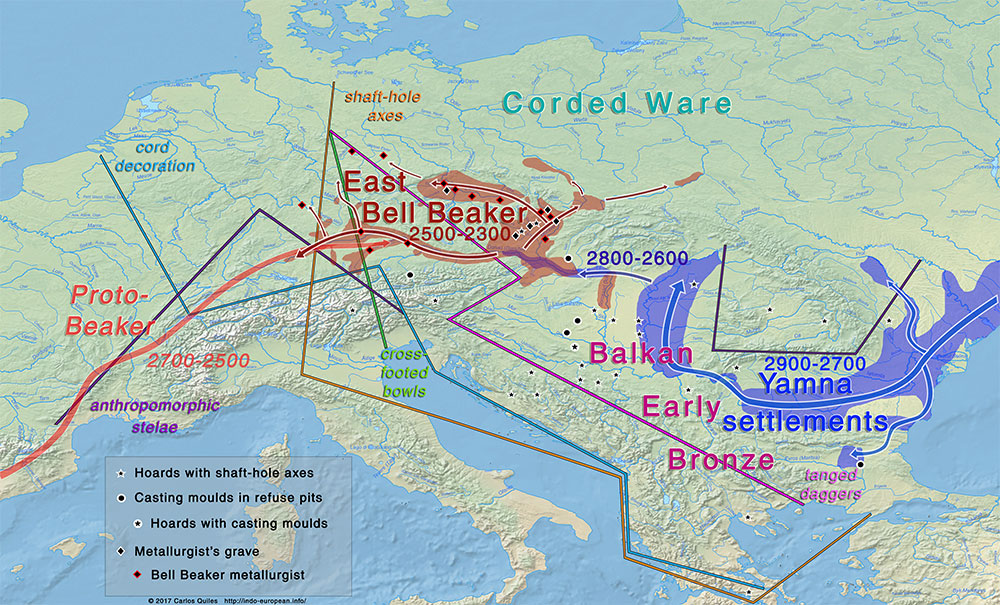Interesting excerpts about local Hungarian groups that had close contacts with Yamna settlers in the Carpathian Basin, from the paper Immigration and transhumance in the Early Bronze Age Carpathian Basin: the occupants of a kurgan, by Gerling, Bánffy, Dani, Köhler, Kulcsár, Pike, Szeverényi & Heyd, Antiquity (2012) 86(334):1097-1111.
The most interesting of the local people is the occupant of grave 12, which is the earliest grave in the kurgan and the main statistical range of its radiocarbon date clearly predates the arrival of the western Yamnaya groups c. 3000 BC. This is also confirmed by the burial rite, which is not typical for the Yamnaya (Dani 2011: 29–33; Heyd in press), although some heterogeneity may apply in Yamnaya communities too. The migrant group, graves nos. 4, 7, 9 and 11, all occupy late stratigraphic positions in the mound, and have radiocarbon dates in the second quarter of the third millennium BC. It is also noteworthy that they are all adult or mature men. The contextual data, their physical distribution over the space of the whole kurgan, and the variety of burial practices, indicate several generations of burials. The cultural attributes of this group are summarised in Figure 5. Overall, their closest match lies in the Livezile group from the eastern and southern Apuseni Mountains, which is also the likely place of origin of the buried persons.

The key question is, what cultural process could be responsible for attracting these men from their homeland to the Great Hungarian Plain, over several generations? Their sex and age uniformity indicate they are a social sub-set within a larger group, implying that only a portion of their society was on the move. Exogamy can probably be excluded, since one would expect more women than men to move in prehistoric times; not to mention the distance of more than 200km between the places of potential origin and burial.
One hypothesis would see these men involved in the exchange of goods, with long-term relations between the mountain and steppe communities. Normally living in, or next to, the Apuseni, these men would journey for weeks into the plain, returning to the same places and people over many decades. Ethnographic examples of such travels to exchange objects and ideas, and perhaps people, are numerous (e.g. Helms 1988). However, the child’s (grave 7a) local isotopic signature would remain unexplained, and one has to wonder for how many generations an exchange continues for four men to die near the Őrhalom.
A second hypothesis is essentially an economic model of transhumance, with livestock passing the winter and spring in the milder regions of the Great Hungarian Plain, and returning to higher pastures in the warmer months (Arnold & Greenfield 2006). Such systems can endure for centuries, provided the social relations underpinning them are stable. This has the advantage of accounting for relatively long periods of time spent away from home, as herdsmen guarded their animals, and perhaps some women and their children came too, which would account for the child’s presence, and the pottery relations of the Livezile group. Furthermore, regular visits to a region would increase the likelihood of Livezile transhumant herders becoming integrated locally. The second quarter of the third millennium BC was a period when Yamnaya ideology, and thus its internal coherence, might have already diminished. This would likely have resulted in a weakened grip by Yamnaya people on pastures and territory, consequently allowing Livezile herders, and potentially others, to step in and take over locally, perhaps first on a seasonal basis and then permanently.
On West Yamna settlers in Hungary

By disclosing very interesting information on (yet unpublished) Yamna samples from Hungary, the latest preprint from the Reich Lab has rendered irrelevant – in a rather surprising turn of events – (what I expected would be) future discussions on West Yamna settlers potentially sharing a similar ancestry with Baltic Late Neolithic / Corded Ware settlers (see here for more details).
Interesting excerpts regarding the tight cluster formed by all Yamna samples:
Individuals from the North Caucasian steppe associated with the Yamnaya cultural formation (5300-4400 BP, 3300-2400 calBCE) appear genetically almost identical to previously reported Yamnaya individuals from Kalmykia20 immediately to the north, the middle Volga region19, 27, Ukraine and Hungary, and to other Bronze Age individuals from the Eurasian steppes who share the characteristic ‘steppe ancestry’ profile as a mixture of EHG and CHG/Iranian ancestry23, 28. These individuals form a tight cluster in PCA space (Figure 2) and can be shown formally to be a mixture by significantly negative admixture f3-statistics of the form f3(EHG, CHG; target) (Supplementary Fig. 3).
Using qpAdm with Globular Amphora as a proximate surrogate population (assuming that a related group was the source of the Anatolian farmer-related ancestry), we estimated the contribution of Anatolian farmer-related ancestry into Yamnaya and other steppe groups. We find that Yamnaya individuals from the Volga region (Yamnaya Samara) have 13.2±2.7% and Yamnaya individuals in Hungary 17.1±4.1% Anatolian farmer-related ancestry (Fig.4; Supplementary Table 18)– statistically indistinguishable proportions.

Before this paper, we had the solidest anthropological models backed by Y-DNA against conflicting data from certain statistical tools applied to a few samples (which some used to contradict what was mainstream in Academia).
NOTE. I have discussed this extensively in this blog, and more than once. See for example my posts on R1a speaking IE (July 2017), on the Eneolithic Ukraine sample (September 2017), or on the “Yamnaya ancestral component” (November 2017).
Today, we have everything – including statistical tools – showing a genetically homogeneous, Late PIE-speaking late Khvalynsk/Yamna community expanding into its known branches, confirming what was described using traditional anthropological disciplines:
- Late Khvalynsk expanding into Afanasevo ca. 3300-3000 BC with an archaic Late PIE dialect, which was attested much later as Tocharian;
- East Yamna/Poltavka admixing with Uralic-speaking Abashevo migrants probably ca. 2600-2100 BC to form Proto-Indo-Iranian-speaking Sintashta-Petrovka and Potapovka;
- and now also Yamna settlers: those in Hungary admixing (probably ca. 2800-2500 BC) with the local population to form North-West Indo-European-speaking East Bell Beakers; those from the Balkans forming other IE-speaking Balkan cultures, including the peoples that admixed in Greece, as seen in Mycenaeans.
If Volker Heyd is right with this and other papers – and he has been right until now in his predictions regarding Yamna, Bell Beaker, and Corded Ware cultures – , the change in ancestry will probably begin to be noticed in Yamna samples from Hungary and the Lower Danube during the second quarter of the 3rd millennium, a period defined by the addition of a more fashionable western Proto-Bell Beaker package to the fading traditional Yamna cultural package.
EDIT (19 MAY 2018): I corrected some sentences and added interesting information.
Related:
- The Caucasus a genetic and cultural barrier; Yamna dominated by R1b-M269; Yamna settlers in Hungary cluster with Yamna
- Brexit forces relocation of one of today’s main Yamna research projects to Finland
- Olalde et al. and Mathieson et al. (Nature 2018): R1b-L23 dominates Bell Beaker and Yamna, R1a-M417 resurges in East-Central Europe during the Bronze Age
- Consequences of Damgaard et al. 2018 (III): Proto-Finno-Ugric & Proto-Indo-Iranian in the North Caspian region
- Consequences of Damgaard et al. 2018 (II): The late Khvalynsk migration waves with R1b-L23 lineages
- North Pontic steppe Eneolithic cultures, and an alternative Indo-Slavonic model
- The concept of “Outlier” in Human Ancestry (III): Late Neolithic samples from the Baltic region and origins of the Corded Ware culture
- New Ukraine Eneolithic sample from late Sredni Stog, near homeland of the Corded Ware culture
- The renewed ‘Kurgan model’ of Kristian Kristiansen and the Danish school: “The Indo-European Corded Ware Theory”